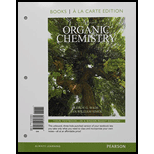
Concept explainers
(a)
To determine: The enantiomers for the given structure, if possible.
Interpretation: The enantiomers for the given structure, if possible, are to be drawn.
Concept introduction: The two different forms in which a single chiral carbon can exist is referred to as enantiomers. The number of enantiomers of a molecule depends on the number of chiral centres. Enantiomers have opposite (R) and (S) configuration.
(b)
To determine: The enantiomers for the given structure, if possible.
Interpretation: The enantiomers for the given structure, if possible, are to be drawn.
Concept introduction: The two different forms in which a single chiral carbon can exist is referred as enantiomers. The number of enantiomers of a molecule depends on the number of chiral centres. Enantiomers have opposite (R) and (S) configuration.
(c)
To determine: The enantiomers for the given structure, if possible.
Interpretation: The enantiomers for the given structure, if possible, are to be drawn.
Concept introduction: The two different forms in which a single chiral carbon can exist is referred as enantiomers. The number of enantiomers of a molecule depends on the number of chiral centres. Enantiomers have opposite (R) and (S) configuration.
(d)
To determine: The enantiomers for the given structure, if possible.
Interpretation: The enantiomers for the given structure, if possible, are to be drawn.
Concept introduction: The two different forms in which a single chiral carbon can exist is referred as enantiomers. The number of enantiomers of a molecule depends on the number of chiral centres. Enantiomers have opposite (R) and (S) configuration.
(e)
To determine: The enantiomers for the given structure, if possible.
Interpretation: The enantiomers for the given structure, if possible, are to be drawn.
Concept introduction: The two different forms in which a single chiral carbon can exist is referred as enantiomers. The number of enantiomers of a molecule depends on the number of chiral centres. Enantiomers have opposite (R) and (S) configuration.
(f)
To determine: The enantiomers for the given structure, if possible.
Interpretation: The enantiomers for the given structure, if possible, are to be drawn.
Concept introduction: The two different forms in which a single chiral carbon can exist is referred as enantiomers. The number of enantiomers of a molecule depends on the number of chiral centres. Enantiomers have opposite (R) and (S) configuration.
(g)
To determine: The enantiomers for the given structure, if possible.
Interpretation: The enantiomers for the given structure, if possible, are to be drawn.
Concept introduction: The two different forms in which a single chiral carbon can exist is referred as enantiomers. The number of enantiomers of a molecule depends on the number of chiral centres. Enantiomers have opposite (R) and (S) configuration.
(h)
To determine: The enantiomers for the given structure, if possible.
Interpretation: The enantiomers for the given structure, if possible, are to be drawn.
Concept introduction: The two different forms in which a single chiral carbon can exist is referred as enantiomers. The number of enantiomers of a molecule depends on the number of chiral centres. Enantiomers have opposite (R) and (S) configuration.
Want to see the full answer?
Check out a sample textbook solution
Chapter 5 Solutions
Organic Chemistry, Books a la Carte Edition (9th Edition)
- Draw the mirror image of each compound. Label each molecule as chiral or achiral.arrow_forwardLabel each molecule with chiral centers (R) and (S). Which ones have more than one?arrow_forwardThis is one enantiomer of the molecule. OH H CCH2-CH2-CH3 CH3 Draw the structure of the other enantiomer using wedges and dashes. Click and drag to start drawing a structure.arrow_forward
- Determine if each compound is identical to or an enantiomer of A.arrow_forwardConsider the compound below. a) Draw the structure showing stereochemistry, in which carbon 1 has S configuration and carbon 2 has R configuration. b) Draw the structure showing stereochemistry, in which carbons 1 and 2 have S configuration. c) are the two structures from part a and b diastereomers, identical, enantiomers, or unrelated?arrow_forwardSaquinavir (trade name Invirase) belongs to a class of drugs called protease inhibitors, which are used to treat HIV (human immunodeficiency virus). OH CONH2 O saquinavir Trade name: Invirase NH a. Locate all stereogenic centers in saquinavir, and label each stereogenic center as R or S. b. Draw the enantiomer of saquinavir. c. Draw a diastereomer of saquinavir. d. Draw a constitutional isomer that contains at least one different functional group.arrow_forward
- Label each enantiomer as R or S. (See attachment)arrow_forward1. An object is chiral if it A. is superimposable on its mirror image B. is not superimposable on its mirror image C. has no mirror image D. is identical to each mirror image of itselfarrow_forwardCompound A is a meso compound. Compounds A and B are enantiomers of each other. Both statements are true. Both statements are false. Only the first statement is true. Only the second statement is true. A B |||||arrow_forward
 Organic Chemistry: A Guided InquiryChemistryISBN:9780618974122Author:Andrei StraumanisPublisher:Cengage Learning
Organic Chemistry: A Guided InquiryChemistryISBN:9780618974122Author:Andrei StraumanisPublisher:Cengage Learning
